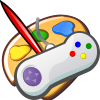Text-based game: Difference between revisions
interwiki |
|||
| Line 73: | Line 73: | ||
--> |
--> |
||
[[es:Videojuego de texto]] |
[[es:Videojuego de texto]] |
||
[[ms:Permainan berdasarkan teks]] |
|||
[[nl:Tekstgebaseerd computerspel]] |
[[nl:Tekstgebaseerd computerspel]] |
||
Revision as of 01:38, 28 August 2010
It has been suggested that this article be merged into Video game graphics. (Discuss) Proposed since July 2010. |
 |
| Part of a series on |
| Video game graphics |
|---|
A text game or text-based game is a video game that uses text characters instead of bitmapped or vector graphics. Text-based games were common from 1970 to 1990, but are still used today.
Overview
Text games are typically easier to write and require less processing power than graphical games, and thus were more common from 1970 to 1990. However, terminal emulators are still in use today, and people continue playing MUDs (multi-user dungeon) and exploring interactive fiction. Many beginning programmers still create these types of games to familiarize themselves with a programming language, and contests even now are held on who can finish programming a roguelike within a short time period, such as seven days.
While many of the earliest computer games (Adventure, Zork) relied on language parsing due to the command line-driven, teletype-terminal mainframe environments in which they were developed, the phrase "text-based" is taken to refer not to the user input (though generally keyboard-based) but rather to exclusive use of the fixed-width character display mode, an important distinction to maintain in light of curses based games such as Rogue and their successors, which employed the characters in the text mode as map symbols rather than as parts of words. Despite enormous differences in display and user interface, the text adventure games and roguelikes both make exclusive use of the text mode, and hence are both to be considered text-based.
Though punctuation and the alphanumeric symbols can be considered standard in most text modes, many of them contain additional symbols and variant attributes (colours, blinking, lines / columns per screen, etc.) that differ between operating environments: the text mode of a Commodore 64 would be substantially different from that of an IBM PC, though despite an absence of standardization in the text display (until implementation of later text mode terminal display standards such as VT100 and ANSI), they would both be considered to be text modes. These later standards also contain numerous characters, largely blocks and lines, specifically intended to be used for fast, low-bandwidth display of crude block graphics in the text mode.
Some games would "redraw" undesired characters to take on the appearance of desired specialty characters (often to indicate the accents, diacritical markings or currencies of foreign countries) otherwise unavailable; though utilising a customized sub-set of it, these games would still be considered to be text based games.
MUD
A MUD (originally Multi-User Dungeon, with later variants Multi-User Dimension and Multi-User Domain),[1] [2] is a multi-user real-time online virtual world. Most MUDs are represented entirely in text, but graphical MUDs are not unknown.[3] MUDs combine elements of role-playing games, hack and slash, interactive fiction, and online chat. Players can read or view depictions of rooms, objects, other players, non-player characters, and actions performed in the virtual world. Players typically interact with each other and the world by typing commands that resemble a natural language.
Roguelike
The roguelike is a sub-genre of role-playing video games, characterized by randomization for replayability, permanent death, and turn-based movement. Many early roguelikes featured ASCII graphics. Games are typically dungeon crawls, with many monsters, items, and environmental features. Computer roguelikes usually employ the majority of the keyboard to facilitate interaction with items and the environment. The name of the genre comes from the 1980 game Rogue.
References
- ^ Bartle, Richard (2003). Designing Virtual Worlds. New Riders. pp. 9–10, 741. ISBN 0-1310-1816-7.
[pp. 9-10] TinyMUD was deliberately intended to be distanced from the prevailing hack-and-slay AberMUD style, and the "D" in its name was said to stand for "Dimension" (or, occasionally, "Domain") rather than "Dungeon;" this is the ultimate cause of the MUD/MU* distinction that was to arise some years later. [pp. 741] The "D" in MUD stands for "Dungeon" [...] because the version of ZORK Roy played was a Fortran port called DUNGEN.
- ^ Hahn, Harley (1996). The Internet Complete Reference (2nd ed.). Osborne McGraw-Hill. p. 553. ISBN 0-07-882138-X.
[...] muds had evolved to the point where the original name was too confining, and people started to say that "MUD" stood for the more generic "Multi-User Dimension" or "Multi-User Domain".
- ^ Bartle, Richard (2003). Designing Virtual Worlds. New Riders. p. 3. ISBN 0-1310-1816-7.
Confusingly, although the term MUD applies to virtual worlds in general, the term MU* does not—it's used strictly for text-based worlds. The introduction of computer graphics into the mix therefore caused a second spate of naming, in order to make a distinction between graphical MUDs and text MUDs.
See also
- List of text-based computer games
- BBS door game
- Online text-based role-playing game
- ANSI art
- ASCII art
- Roguelike
- Text user interface
